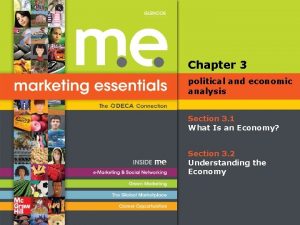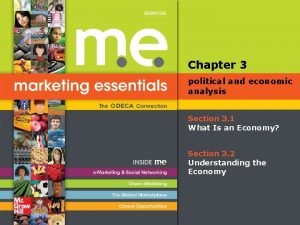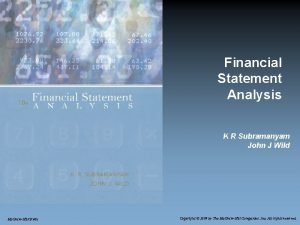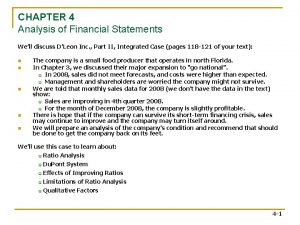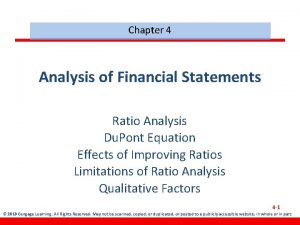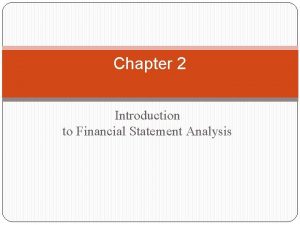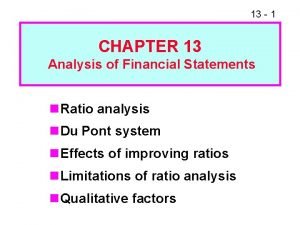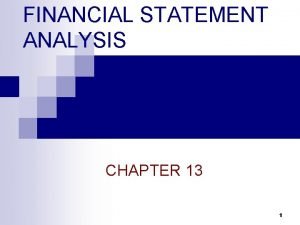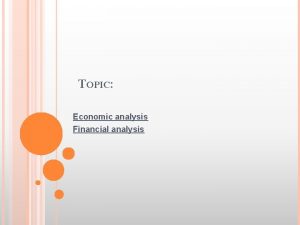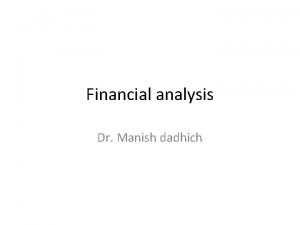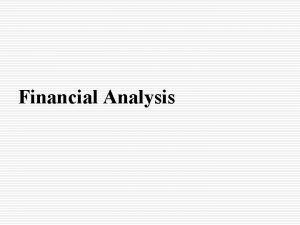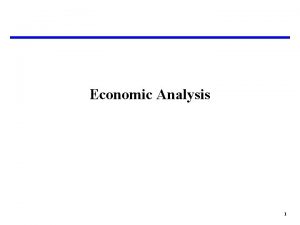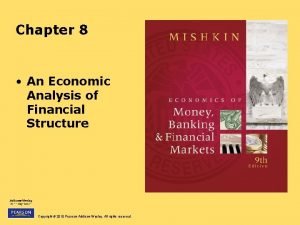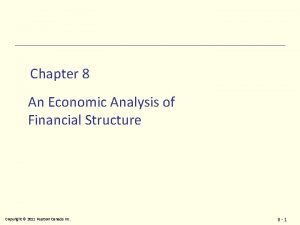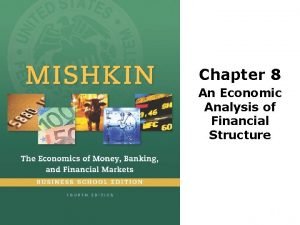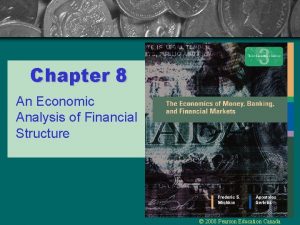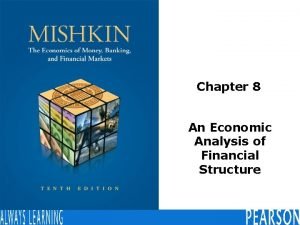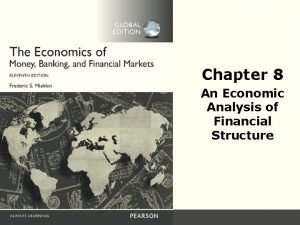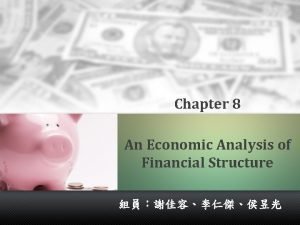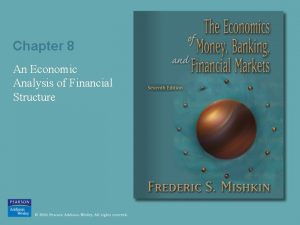Chapter 8 An Economic Analysis of Financial Structure















- Slides: 15

Chapter 8 An Economic Analysis of Financial Structure © 2005 Pearson Education Canada Inc.

Sources of External Finance in Canada © 2005 Pearson Education Canada Inc. 2

Sources of Foreign External Finance © 2005 Pearson Education Canada Inc. 3

Puzzles of Financial Structure 1. Stocks are not most important source of external finance for businesses 2. Issuing marketable securities not primary funding source for businesses 3. Indirect finance (financial intermediation) is far more important than direct finance 4. Banks are most important source of external finance 5. Financial system is among most heavily regulated sectors of economy 6. Only large, well established firms have access to securities markets 7. Collateral is prevalent feature of debt contracts 8. Debt contracts are typically extremely complicated legal documents with restrictive covenants © 2005 Pearson Education Canada Inc. 4

Transaction Costs and Financial Structure Transaction costs hinder flow of funds to people with productive investment opportunities Financial intermediaries make profits by reducing transaction costs 1. Take advantage of economies of scale Example: Mutual Funds 2. Develop expertise to lower transaction costs Explains Puzzle 3 © 2005 Pearson Education Canada Inc. 5

Adverse Selection and Moral Hazard: Definitions Adverse Selection: 1. Before transaction occurs 2. Potential borrowers most likely to produce adverse outcomes are ones most likely to seek loans and be selected Moral Hazard: 1. After transaction occurs 2. Hazard that borrower has incentives to engage in undesirable (immoral) activities making it more likely that won’t pay loan back © 2005 Pearson Education Canada Inc. 6

Adverse Selection and Financial Structure Lemons Problem in Securities Markets 1. If can’t distinguish between good and bad securities, willing to pay only average of good and bad securities’ values. 2. Result: Good securities undervalued and firms won’t issue them; bad securities overvalued, so too many issued. 3. Investors won’t want to buy bad securities, so market won’t function well. Explains Puzzle 2 and Puzzle 1. Also explains Puzzle 6: Less asymmetric information for well known firms, so smaller lemons problem © 2005 Pearson Education Canada Inc. 7

Tools to Help Solve Adverse Selection (Lemons) Problem 1. Private Production and Sale of Information Free-rider problem interferes with this solution 2. Government Regulation to Increase Information Explains Puzzle 5 3. Financial Intermediation A. Analogy to solution to lemons problem provided by used-car dealers B. Avoid free-rider problem by making private loans Explains Puzzles 3 and 4 4. Collateral and Net Worth Explains Puzzle 7 © 2005 Pearson Education Canada Inc. 8

Moral Hazard: Debt versus Equity Moral Hazard in Equity: Principal-Agent Problem 1. Result of separation of ownership by stockholders (principals) from control by managers (agents) 2. Managers act in own rather than stockholders’ interest Tools to Help Solve the Principal-Agent Problem 1. Monitoring: production of information 2. Government regulation to increase information 3. Financial intermediation 4. Debt contracts Explains Puzzle 1: Why debt used more than equity © 2005 Pearson Education Canada Inc. 9

Moral Hazard and Debt Markets Moral hazard: borrower wants to take on too much risk Tools to Help Solve Moral Hazard 1. Net worth 2. Monitoring and enforcement of restrictive covenants 3. Financial intermediation Banks and other intermediaries have special advantages in monitoring Explains Puzzles 1– 4. © 2005 Pearson Education Canada Inc. 10

Summary: Asymmetric Information Problems and Tools to Solve Them © 2005 Pearson Education Canada Inc. 11

Financial Development and Economic Growth Financial Repression Leads to Low Growth: Why? 1. Poor legal system 2. Weak accounting standards 3. Government directs credit 4. Financial institutions nationalized 5. Inadequate government regulation © 2005 Pearson Education Canada Inc. 12

Financial Crises Factors Causing Financial Crises 1. Increase in interest rates 2. Increases in uncertainty 3. Asset market effects on balance sheets Stock market effects on net worth Unanticipated deflation Cash flow effects 4. Bank panics 5. Government fiscal imbalances © 2005 Pearson Education Canada Inc. 13

Events in Financial Crises in Canada © 2005 Pearson Education Canada Inc. 14

Events in Mexican, East Asian, and Argentine Financial Crises © 2005 Pearson Education Canada Inc. 15
 Economic growth vs economic development
Economic growth vs economic development Conclusion of growth and development
Conclusion of growth and development Economic systems lesson 2 our economic choices
Economic systems lesson 2 our economic choices Chapter 3 political and economic analysis
Chapter 3 political and economic analysis Chapter 3 political and economic analysis
Chapter 3 political and economic analysis Summary of ratio analysis
Summary of ratio analysis Financial statement analysis subramanyam ppt chapter 2
Financial statement analysis subramanyam ppt chapter 2 Chapter 03 financial analysis
Chapter 03 financial analysis Chapter 14 financial statement analysis solutions
Chapter 14 financial statement analysis solutions Chapter 4 analysis of financial statements
Chapter 4 analysis of financial statements Chapter 4 analysis of financial statements
Chapter 4 analysis of financial statements How to improve current ratio
How to improve current ratio Chapter 2 financial statement analysis solutions
Chapter 2 financial statement analysis solutions Chapter 13 financial statement analysis
Chapter 13 financial statement analysis Chapter 13 financial statement analysis
Chapter 13 financial statement analysis Chapter 1 overview of financial statement analysis
Chapter 1 overview of financial statement analysis



